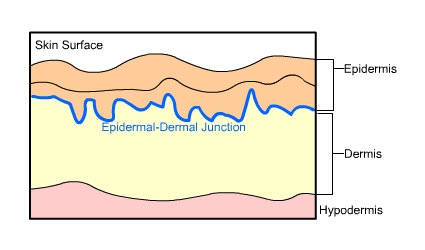Better Skin: It’s Not What You Put On It, It’s What You Put In It

For healthy-looking skin, what goes into your body is more important than what goes on it.
People spend billions of dollars each year on skin care products of every description, all in hopes of achieving clearer, healthier or younger-looking skin. But before you spend another dime on an overpriced/overhyped moisturizer, think about this; any skin you can see is dead tissue, and as such, there isn’t much you can put on it to make meaningful, long term changes in its health or appearance. To achieve that, you’ve got to cultivate good skin from the inside out. Here’s your simplified guide to good-skin nutrition.
Although we don’t usually think of it that way, anatomically, your skin is an organ, every bit as much as your liver, kidneys and other more familiar organs. Just as any organ, though, your skin has specific functions to perform, and its physical structure suits it to perform those functions. Structurally, skin has some unique features that give us an insight into what approaches can make a meaningful difference in skin versus those that make only superficial difference.
One of the unique things about skin tissue is that it’s dead on one side, living on the other, and between these two zones are layers of skin somewhere between being dead and alive. That’s an oversimplification because there are many functionally and structurally-distinct layers of skin from the surface inward. But the point is that living skin tissue exists only in the deepest layers of skin (the dermis) while the skin’s surface consists entirely of dead skin cells.
The main reason for this is that the dermis has something the epidermis does not; the dermis is richly supplied with blood vessels that support the living cells there by bring oxygen and nutrients and ferrying away wastes. The skin’s surface layers, referred to collectively as the epidermis, have no blood vessels. Instead, nutrients must diffuse upward from the top layers of the dermis to the bottom layers of the epidermis; this is a much poorer method of delivery than the bloodstream. When fewer nutrients are present in the bloodstream (as is the case with a poor diet), it’s now that much harder to support the epidermal cells. The result is that their growth is less robust and they die sooner, leading to thinner less robust-looking skin. This is a fundamental connection between nutrition and skin health.
As the epidermal cells grow and divide, they are pushed upward and ever-farther away from their supply of nutrients. At a certain point, diffusion of nutrients is no longer sufficient to support these cells which die as a result. The layers of dead skin cells remain intact, however, and these tightly-compacted cells form a barrier 25-30 layers deep. Its dense arrangement of cells and its structure make the epidermis waterproof and able to resist absorbing a very wide range of chemicals and foreign substances.

Nourish the outer layer of skin (epidermis) by nourishing the innermost layers (dermis).
This protective barrier is one of skin’s most essential functions and human survival depends on it.
This is a major reason why nutrition is a much more powerful way to improve skin that topical treatments. Cleansing, moisturizing and exfoliating are all important and you don’t need to stop doing any of them. But no matter what the claims are, there are real limits to what you can achieve by putting something on dead skin, because of the skin’s barrier-like properties and because those skin cells are dead and unable to respond to any kind of treatment except in the most superficial way. As a crude analogy, think of old peeling paint on a house. You can remove that old paint, paint over it, or ignore it, but you can’t make old paint newer paint.
The dynamic part of skin, the only part of skin tissue that is able to respond to your interventions is essentially inaccessible from the surface.
It’s not impossible to penetrate skin – there are many topical drugs and other chemicals that can penetrate skin significantly, but at the same this property also raises their risks and limits the extent of their use. This approach makes sense for drugs and medications but not whole-body skin treatments.
The living skin is beneath the surface is a dynamic tissue that responds to nutritional improvements and nutritional deficits, dead skin cannot respond.
So if you want better skin, cleansing and moisturizing don’t become un-important, but there’s much more to be gained by working from the inside out; cleaning up your diet, eating healthier and taking a few supplements since no diet can give you everything your body needs.
Step 1. Eliminate added sugar, sugary foods and refined carbohydrates from your diet.
There has never been complete agreement as to why or how sugar worsens skin health in so many people, and it may not be true for everyone, but a high-glycemic or high-sugar diet, besides being unhealthy in 100 other ways, most commonly makes skin oilier and worsens problems like acne that are related to excessive oil production. Best-selling author Dr. Nicholas Perricone posits that sugar causes a destructive cascade of inflammation within skin tissue. It might also be that oil-producing glands are much more sensitive to high or unstable blood sugar levels than other tissue. But it is clear that a high-sugar diet is particularly detrimental to skin, so that is the first thing to straighten out. Use sugar-free or low-carb alternatives wherever possible.
Step 2. Take a Multivitamin, a Fish Oil Supplement and extra Vitamin D
These two supplements cover the most important nutritional bases on a day-to-day basis. Consider using one of the many excellent Hair, Skin and Nail multivitamins instead of an ordinary multi. You may also want to use a protein supplement every day since optimal skin, hair and nail growth depend on adequate quantities of protein. Unless you are outside on a regular basis, boost your multi with a 400-1000 IU Vitamin D supplement daily.
Step 3. Eat Fruits and Vegetables Everyday
Fruits and vegetables should be the very basis of your diet, but in real-world terms, it’s hard to eat enough of these foods on a consistent basis. But because of the wide range and dense concentration of nutrients they possess, there is no substitute for eating fruits and vegetables. They can’t be replaced with supplements for all practical purposes. Pack an apple into your lunch bag. Throw a baggie of carrot sticks into your backpack. Have a salad or share a salad every time you eat out. It’s not hard and it’s but one of the best habits you can establish not just for skin health, but overall health.

Fruits and vegetables are the best foods for skin and overall health.
Step 4. Get More Antioxidants
Skin is exposed to a wide-range of factors that cause oxidative free-radical damage. Anti-oxidants help protect against this kind of damage but most no anti-oxidant protects against all types of free-radicals. Therefore you want as wide a range of antioxidants as possible. This is another good reason to consume lots of fruits and vegetables. Iced or hot green tea, with a low-carb or no-carb sweetener is an easy inexpensive way to get powerful antioxidants. Other antioxidants that are particularly good for skin include vitamins A and C, grape seed extract, alpha lipoic acid and astaxanthin. You can use any or of all these together for a powerful skin-support regimen.
Step 5. Drink Plenty of Water
Drinking 1-3 liters of pure drinking water every day will help keep skin hydrated and often improves the appearance of skin irrespective of other factors.
Step 6. Non-nutritional Factors
Finally, you also want to eliminate all those non-nutritional things which undermine skin health; smoking, excessive drinking, over-or-underexposure to sunlight, overuse of cosmetics, over exposure to harmful chemicals and many drugs (illicit, prescription and OTC) can all adversely impact the health and appearance of skin. You must discuss concerns about prescription drugs with your doctor, but all of these other factors are under your control and should be eliminated or reduced. Use a sunscreen when you know you’ll be exposed for long periods of time, but recognize that you do need regular unprotected exposure as well.
Then, be consistent and be patient.
Remember that skin grows from the inside out. Just as you wouldn’t expect immediate or dramatic effects from putting fertilizer into a garden plot, these skin-support strategies aren’t likely to provide immediate or drastic results. But if you cover as many of these bases as you can, you will soon see improvements in the apperance and health of your skin while supporting whole-body health as well.
- Posted in Human Body 101, Miscellaneous, Women's Health
- 1 Comment



